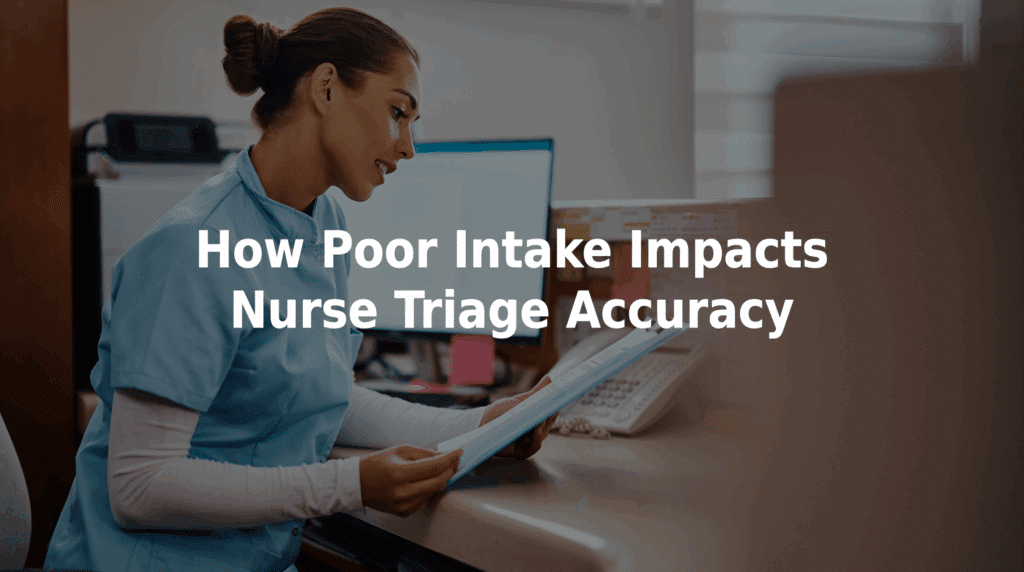How Poor Intake Impacts Nurse Triage Accuracy
When patient intake messages are incomplete or vague, nurse triage may not be as accurate as it should be — and neither will care quality. For nurse managers who are overseeing clinical teams and care coordination, poor message intake by nonclinical staff can lead to inappropriate triage decisions, unnecessary follow-ups, and — in worst-case scenarios — missed diagnoses.
Why Nurse Triage Depends on Clear Intake
Triage nurses rely on timely, specific, and clinically relevant details to determine the urgency of each patient’s condition. When messages are inconsistent or lack important context like symptom onset, severity, or associated signs, then nurses must either delay action to follow up with those patients, or risk putting care at a lower priority than needed.
Even highly skilled nurses can only triage as accurately as the information they receive. The intake process is the foundation of safe and effective telephone triage.
Key Ways Poor Intake Affects Triage Accuracy
1. Incomplete Symptom Descriptions
Nurses often receive vague messages like “has a headache” or “needs a medication refill” without supporting information. This forces them to make judgment calls without adequate data.
2. Delayed Nurse Responses
When intake messages require clarification, it adds time to every interaction — especially in high-volume settings.
3. Missed Red Flags
Symptoms like chest discomfort or abdominal pain may be benign or serious. Without context, they can be misclassified and lead to undertriage.
4. Burnout From Rework
Nurses already face intense workloads. Repeat callbacks to clarify symptoms can increase frustration and reduce care efficiency.
5. Increased Risk of Liability
If incorrect triage decisions stem from poor intake documentation, practices may be held liable.
Best Practices for Improving Intake for Triage Nurses
- Implement Standardized Intake Protocols
Structured prompts mean that key symptoms and clinical red flags are always collected. - Train Nonclinical Staff on Escalation Criteria
Help intake operators recognize when symptoms warrant a nurse’s immediate attention. - Use Technology to Collect Data Directly From Patients
Allowing patients to input their own symptoms through a guided interface can improve message accuracy and timeliness. - Integrate Intake With Triage Workflows
Verify that intake data can sync directly with nursing platforms or EHRs for effective clinical use. - Monitor and Audit Intake Quality
Review messages periodically to identify trends and train staff accordingly.
Case Insight: Avoiding a Missed Stroke
A 72-year-old woman reported vertigo and requested a refill through a nonclinical operator. The message was treated as nonurgent until a nurse manager caught it, called the patient back, and discovered additional symptoms — headache and arm weakness — leading to an immediate 911 referral for stroke evaluation.
Had that follow-up not occurred, triage based on the original intake would have delayed critical care.
How Nurse Managers Can Drive Improvement
Nurse managers often have the position and authority to champion improvements to medical message intake. For them, we think the best option is to evaluate how self-reporting technology can expedite messages while also ensuring greater accuracy.
Improve Intake, Improve Triage
MedMessage Automate is TriageLogic’s solution to intake. It allows patients to securely submit information about their symptoms through structured, digital prompts. This reduces the chances of missing key details and ensures that triage nurses receive complete, clinically useful messages.
Here’s what our solution offers:
- Dynamic intake forms backed by clinical knowledge
- Symptom-specific templates
- Fewer nurse callbacks
- Better triage decision support
- Integration with in-house systems and EHRs
Help Your Team Work Smarter, Not Harder
Let’s make sure that your triage team has accurate, timely, and actionable information for every patient request. Contact us today to learn more about MedMessage Automate and schedule a demo!

